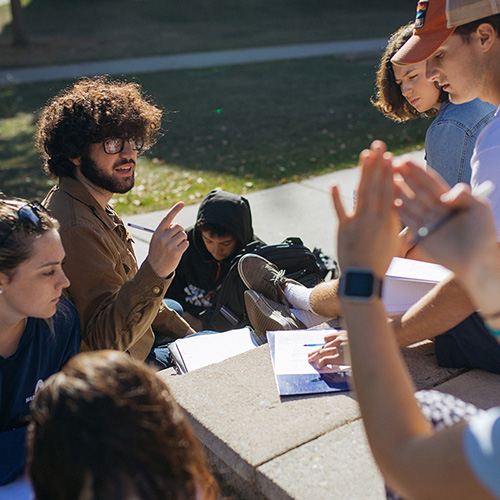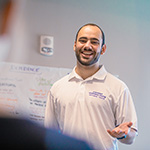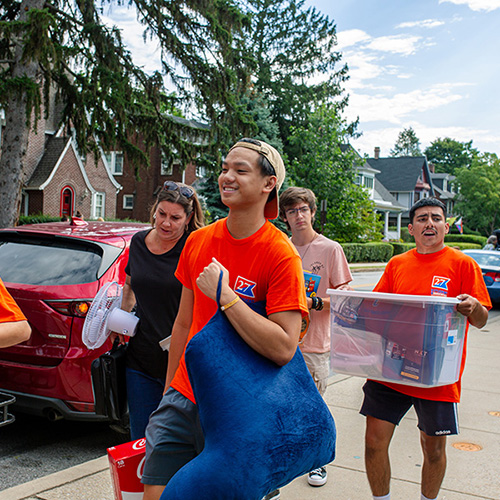
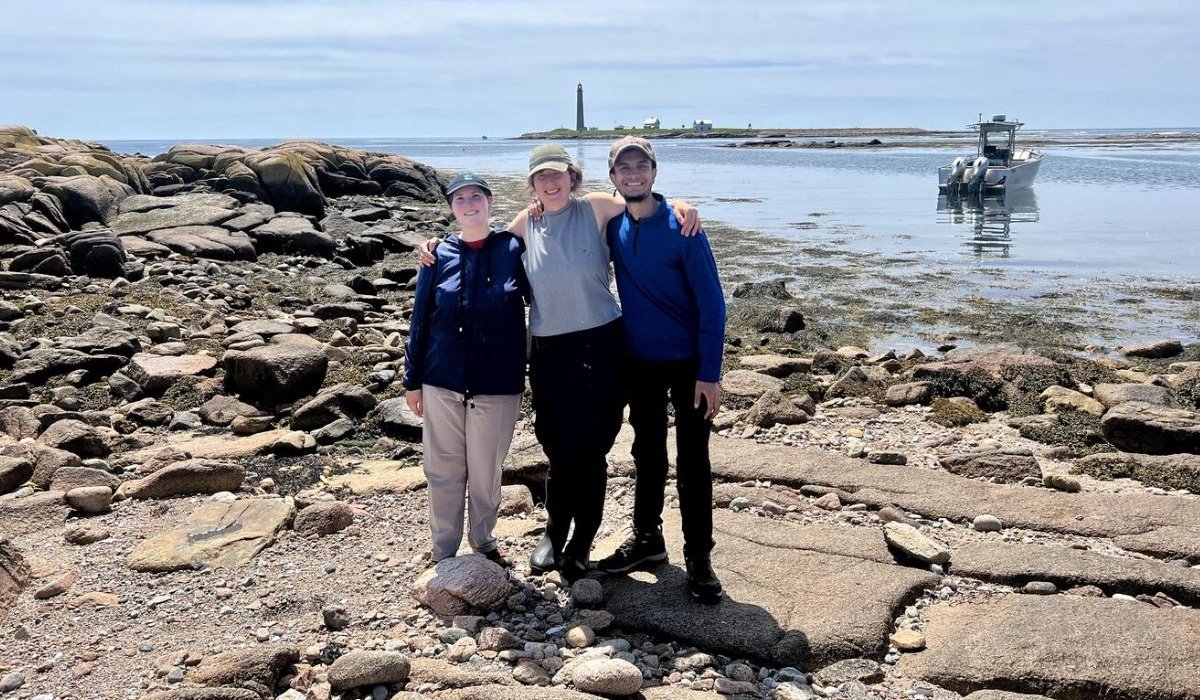
More than half of Gettysburg College students collaborate with professors before they graduate, and this past summer, as part of the Cross-Disciplinary Science Institute (X-SIG), Environmental Studies Prof. Tasha Gownaris ’09, Jehan Mody ’24, and Kaiulani Sund ’23 worked alongside the United States Fish and Wildlife Service staff on Petit Manan Island, a 10-acre island that is part of the Maine Coastal Islands National Wildlife Refuge Complex.
Now in its 10th year, X-SIG is a research community dedicated to pursuing science’s most pressing questions and preparing students for life after graduation. For two months, Gownaris, Mody, and Sund called a lighthouse keeper’s house their home, as it was surrounded by the topic of their X-SIG research—thousands of breeding seabirds, including puffins and terns.
“One of the things I like a lot about Gettysburg is the low student-to-faculty ratios,” said Mody. “It allows me to work closely with my professors and build a rapport with them inside and outside the classroom. Research experiences like X-SIG further this bond and make for some great times.”
“I can definitely say that this field season has prepared me for future careers, and I will bring with me the mentality that mistakes—and successes—are part of learning.”
— Kaiulani Sund ’23
As a first-generation college student, Gownaris also found it rewarding to spend her summers researching in Maine with mentor and Environmental Studies Prof. Emeritus John Commito, an experience that came full circle when she began studying seabirds with Mody and Sund just miles from her undergraduate research site.
“Dr. John Commito put me on the path that I am on today. Most faculty call him John, but he’s still ‘Doc’ to me,” Gownaris said. “Learning to navigate the world of research with Doc’s help was a challenging but empowering and life-changing experience. … Conducting this type of work also sparks personal growth. It teaches patience, attention to detail, thoughtfulness, and commitment. I am so excited to be able to provide my students similar experiences and thankful to X-SIG and the U.S. Fish and Wildlife Service for the opportunity to do so.”
Gownaris, Mody, and Sund are studying how seabirds adapt their foraging behavior in response to rapid shifts in climate and food availability, also known as behavioral plasticity. In the field, they collected stable isotope samples and data on chick provisioning, both of which will tell them about seabird foraging and diet.
“I’ve started to understand what conducting research is like, the intricacies involved outside of the time spent in the field, and so much more,” Mody added. “These experiences can open many great pathways for students’ futures and they also give the faculty some useful assistance in their projects without having to look far for research assistants.”
Go inside their work and learn more about this immersive X-SIG opportunity:
What inspired this X-SIG?
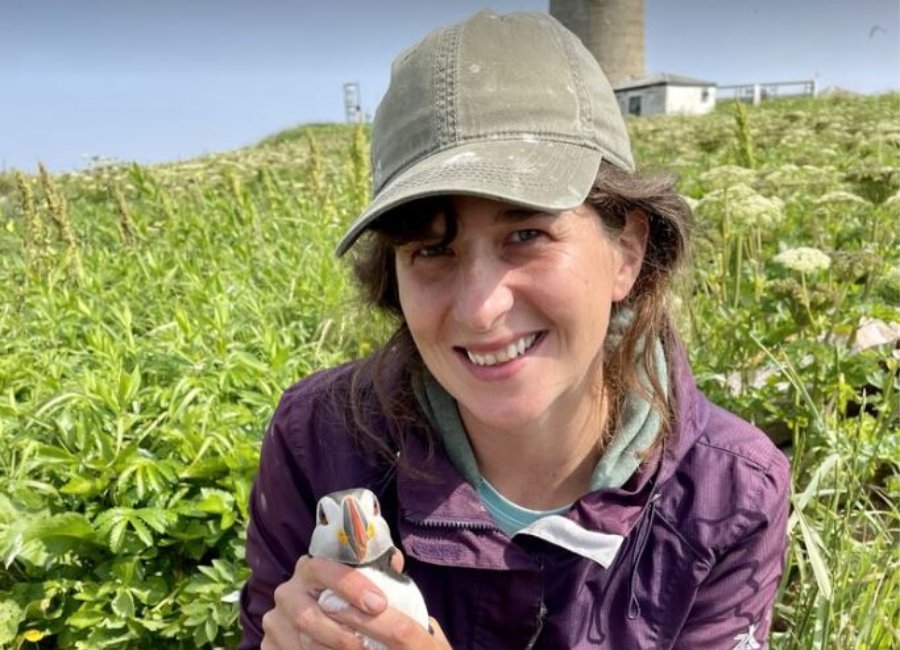
Prof. Tasha Gownaris ’09:
“I started my career as a marine scientist as an undergraduate at Gettysburg College, where I studied the movement response of blue mussels, Mytilus edulis, to their predators. As a graduate student, I studied fish populations in Kenya, where I would spend weeks at a time collecting samples and data. I fell in love with fieldwork. I also adopted two parrots as pets and became interested in birds and bird behavior.
“So, as a post-doctoral researcher at the University of Washington, I decided to merge these interests by studying how fish availability impacted chick growth and survival in Magellanic penguins. Each year, I would spend weeks living among the penguins at Punta Tombo, Argentina. These experiences changed my life and, when I became a professor, I knew I wanted to share them with the next generation of scientists.
“During my first year as a faculty member at Gettysburg, I sat next to Linda Welch, the supervisory wildlife biologist with Maine Coastal Islands, at breakfast during a conference. I feel so lucky that I did because our discussion led to this ongoing collaboration on Petit Manan Island. Linda and her team, who have been monitoring Petit Manan for decades, have amassed incredible datasets on the seabirds and a deep, nuanced understanding of their natural history.”
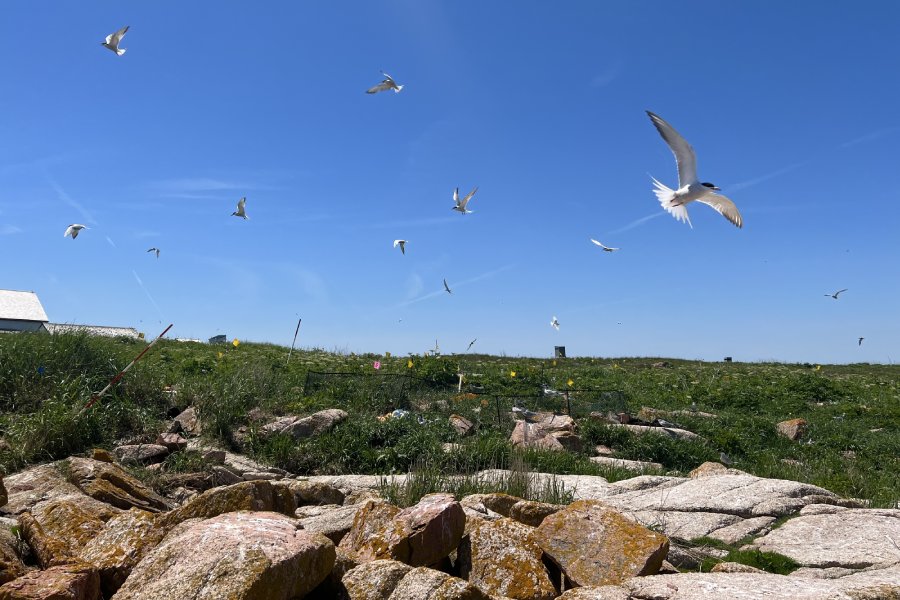
Why did you select the Gulf of Maine for this X-SIG research?
Gownaris:
“The Gulf of Maine is a special place. There are 13 seabirds that breed on the offshore islands there, many of which are exhibiting population decline. These seabird species are diverse and each is unendingly fascinating. For example, one of the species we study, Arctic terns, weigh about 120 grams and make the longest distance annual migrations of any animal on earth—flying from the Arctic to the Antarctic and back again each year. These terns weigh 15 grams or less when they hatch and, after a few weeks of growing up on land, must fly out to the sea and learn how to find food in the vast, complex, and rapidly changing ocean.
“Change in the Gulf of Maine is particularly rapid. Due to global-scale warming and regional-scale changes in ocean circulation, the Gulf of Maine is warming faster than 99.5% of the ocean. Long-term changes are punctuated by brief and destructive marine heatwaves that drive fish deeper and farther offshore, making it harder for seabird parents to raise their chicks. Last year, the marine heatwaves kept on coming, resulting in a lack of food for seabirds and their chicks. This lack of food and climate-driven increases in extreme rain events led to high rates of starvation and hypothermia, respectively, and low tern and puffin chick survival.”
Why did you want to join this X-SIG?
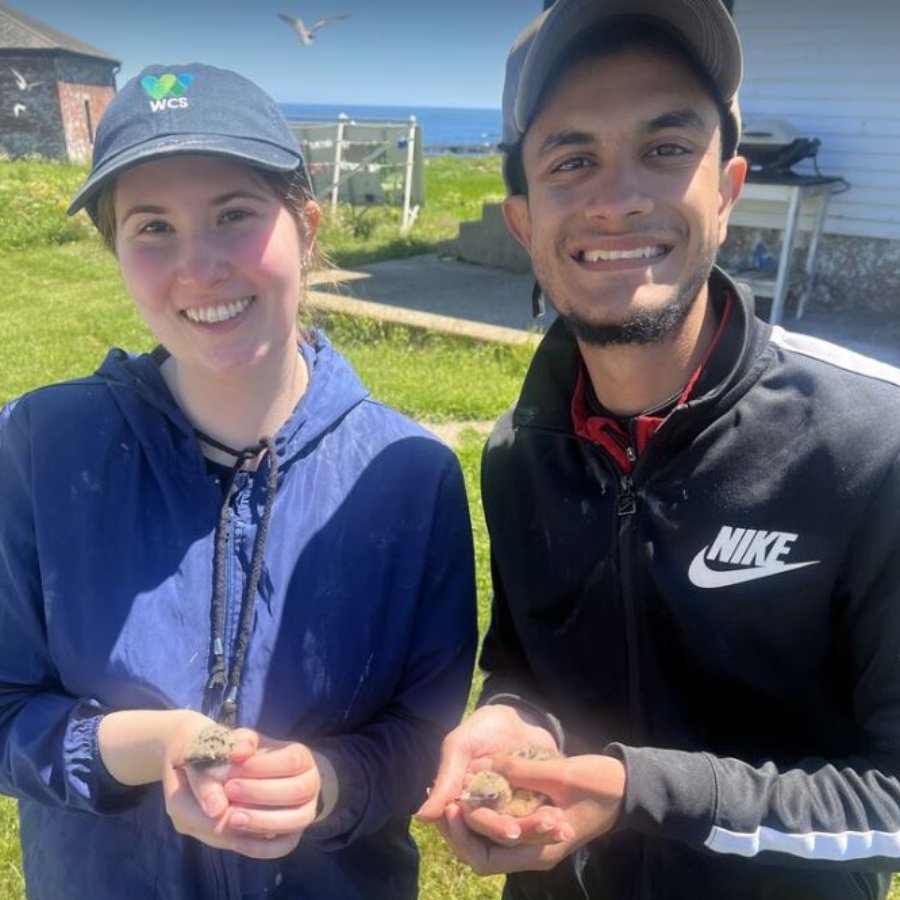
Jehan Mody ’24, biology and environmental studies double major:
“One of the reasons why I chose Gettysburg was for the opportunity to conduct research as an undergraduate, an option not available to students at larger universities. I knew this would help me gain experience at a young age and also strengthen my chances of getting into graduate school. The X-SIG program was a great way for me to gain this research experience and it gives me the chance to think about what I want to do after college. I had class with Tasha this past year and on our field trips throughout the semester I had a great time working with her. We talked about the work she was doing, and even though I had never planned to work with birds, I found a lot of positive takeaways from this work and have a newfound admiration for seabirds. This project has a lot of rewarding aspects when it comes to conservation of animals, and it was an experience I wanted to get a sense of personally with my future in mind.”
Kaiulani Sund ’23, environmental studies major:
“It was an undergraduate opportunity that I knew was special and unique to Gettysburg. I also knew I wanted to complete an honor’s thesis and this summer research would provide me with many experiences that would not only contribute to my senior research, but also prepare me for future work in graduate school and beyond. … This season, I learned how to conduct data collection, management, and sample processing, as well as interacting with others professionally in a work environment.”
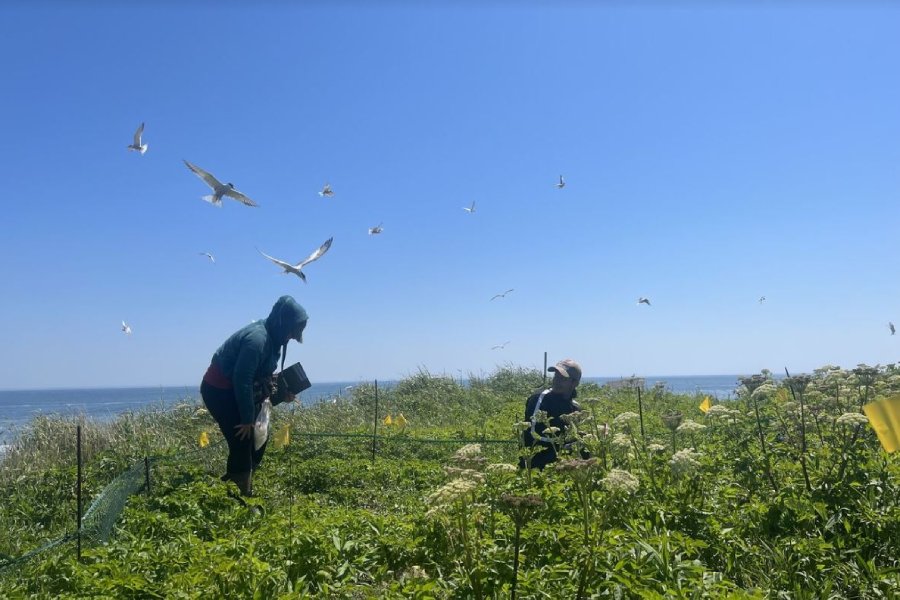
What did your days entail?
Gownaris:
“This work requires early mornings, long days, a high tolerance for getting pooped on, and so, so much learning. Nearly every day, the students learned to do something new. It also required that we are incredibly thoughtful of the seabirds, the resources we use, and the people we live with. For example, Arctic and common terns are ground-nesting species and their chicks often hide under vegetation, so we needed to carefully watch each and every step we take on the island to make sure their eggs and chicks stay safe. In the house, we were conscientious of our use of water, propane for cooking, solar-generated power, and other resources and proactive about making sure we help with all of the tasks necessary to keep the seabird monitoring program up and running.”
Sund:
“Our days on the island were full of activities!
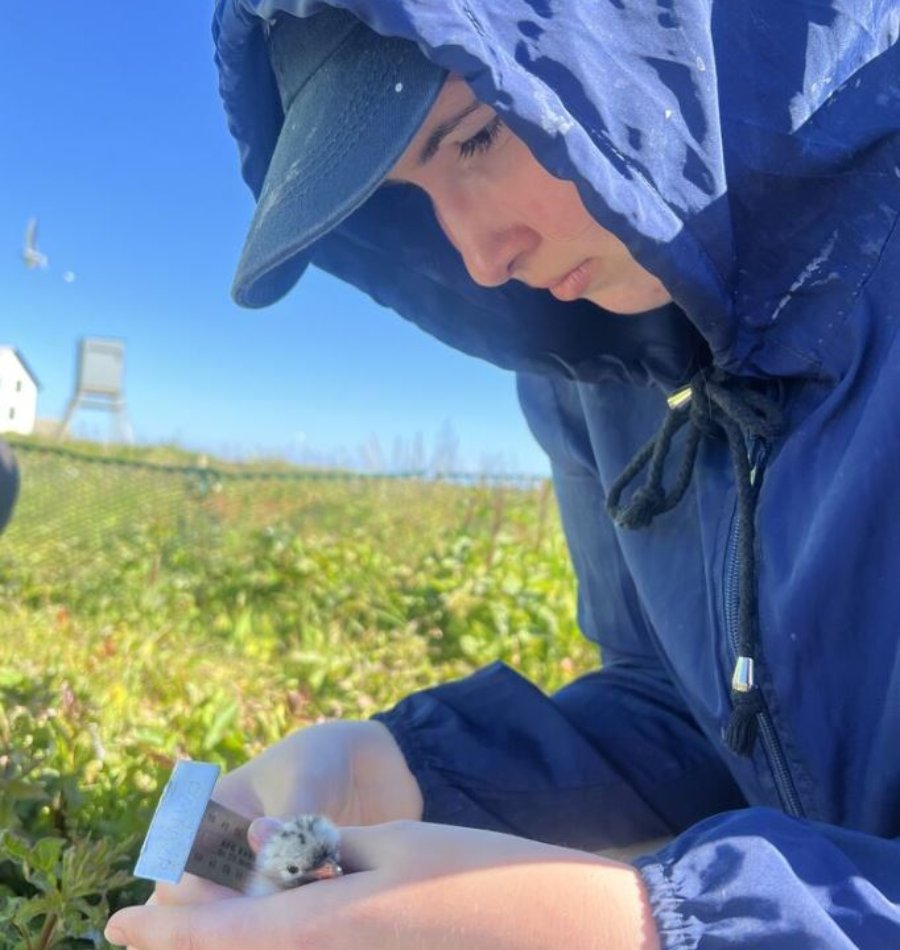
6 a.m.
We started off with three-hour tern provisioning stints. This consists of watching multiple nests, many of which have multiple chicks, and recording diet data. This includes prey species, size in comparison to the bill length of the adult tern, which nest, and which chick receives the fish.
9 a.m.
We then took a coffee and breakfast break before heading out for tern productivity. There were several plots across the colony that contain multiple nests in which the eggs were checked every day for incubation status and pipping progress. Once chicks were born, we banded them and took weight and wing chords every other day. Toward the end of the season, we got to see many of these chicks fledge (leave their nests for the ocean), which was super exciting!
12-5 p.m.
Afternoon activities varied by day. With puffins, we checked burrows for adults and eggs or pufflings (puffin chicks), banded adults and pufflings, and took LGR (linear growth rate) measurements of chicks. Black guillemot nests were also checked for chicks, which also get LGR measurements. Other activities included resighting of Arctic tern and puffin bands, deterring gulls, and island-wide counting of seabirds from the lighthouse, which Jehan did in the evening.
We also collected a lot of samples for our research. Blood sampling went well; we collected two samples from most chicks in the productivity plots and these samples will be analyzed for stable isotope signatures. We can use these signatures to learn more about where the seabirds are foraging and what types of items they are feeding their chicks. We also collected eggshells from terns, puffins, and guillemots. Jehan will focus on analyzing the membrane samples to provide an insight into the seabird mom’s diet when she laid the egg and into how this influences chick growth. The tern provisioning data will form the basis of Kaiulani’s honors thesis, which will focus on how individual terns alter their foraging behavior in response to marine heatwaves.
Blood samples and eggshell membrane processing is ongoing but, so far, provisioning has shown that chicks are eating well. We saw a good amount of hake and herring, which are some of the best diet items for chicks. Unfortunately, we have seen some butterfish, a species that is too deep-bodied for chicks to swallow, and the occasional invertebrate. Food availability started to decline later in the season but, luckily, the terns bred early this year, allowing many of the chicks to fledge before this time.”
What are your biggest takeaways from this X-SIG experience?
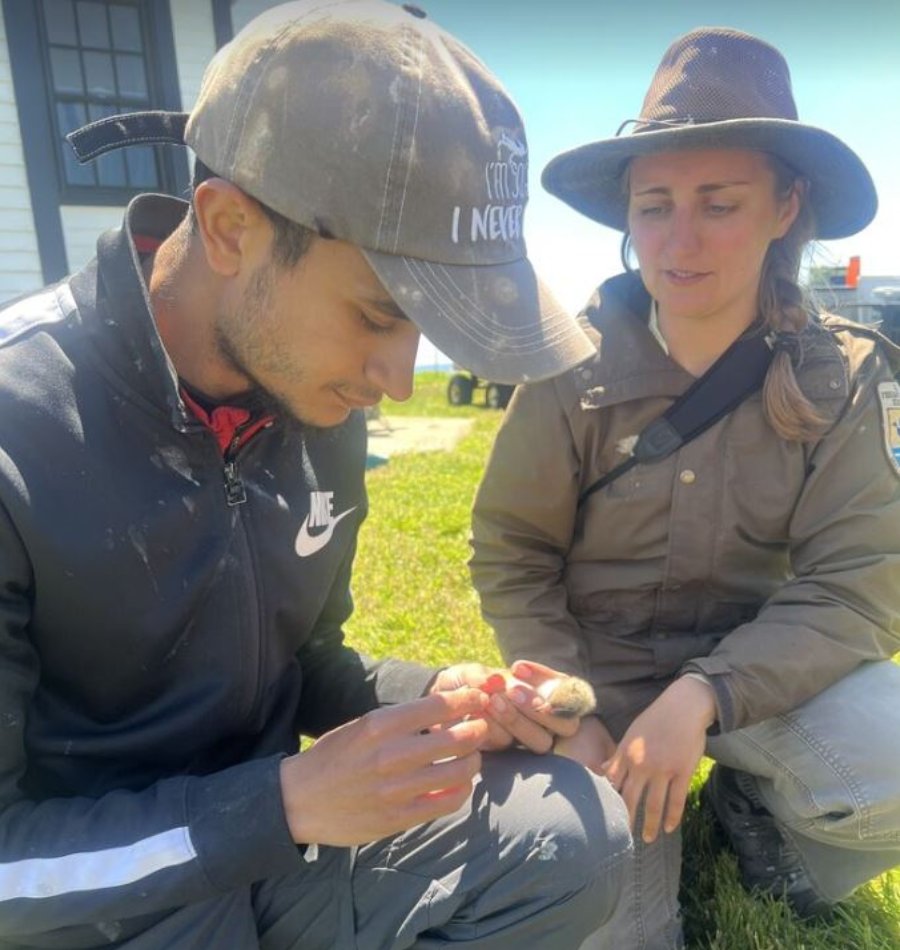
Mody:
“Being able to get my first full field season under my belt is a big takeaway for me from this experience. It has been an influential experience in thinking about my future, the kind of research I can venture into, and the animals I would want to work with. Furthermore, I have spent the season with a small group of people in a remote location and that has been a new experience that I can expect with future field seasons. Almost every day I’ve learned a new skill or lesson and I’ve been able to add a lot more tools to my box that I can bring into future seasons. Spending a whole season in the field has also increased my appreciation for the beauty of life around us and encouraged my passion for conservation.”
Sund:
“I knew going into this field season I would learn a lot about working with other researchers as well as animals I had never been so close to before. The biggest takeaway for me was that field work is a learning process. You can do your best to prepare for fieldwork by reading papers and protocols, but once you are immersed, you face new challenges that you could not predict. Conservation is a field I am passionate about and being able to be behind the scenes and involved in the very processes that support these birds’ populations was an amazing experience. I can definitely say that this field season has prepared me for future careers and I will bring with me the mentality that mistakes—and successes—are part of learning.”
Learn more about student-faculty research at Gettysburg College.
By Megan Miller
Photos courtesy of Prof. Tasha Gownaris ’09, Jehan Mody ’24, and Kaiulani Sund ’23
Posted: 11/02/22
